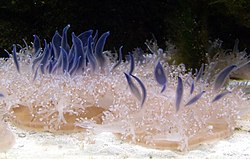| Revision as of 08:44, 18 April 2013 editEmausBot (talk | contribs)Bots, Template editors2,862,718 editsm Bot: Migrating 1 interwiki links, now provided by Wikidata on d:Q1048402← Previous edit | Revision as of 02:18, 5 July 2013 edit undo27.145.11.6 (talk)No edit summaryNext edit → | ||
| Line 41: | Line 41: | ||
| {{Commonscat|Cassiopea andromeda}} | {{Commonscat|Cassiopea andromeda}} | ||
| ] | ] | ||
| ] | |||
Revision as of 02:18, 5 July 2013
| Cassiopea andromeda | |
|---|---|

| |
| Scientific classification | |
| Kingdom: | Animalia |
| Phylum: | Cnidaria |
| Class: | Scyphozoa |
| Order: | Rhizostomae |
| Family: | Cassiopeidae |
| Genus: | Cassiopea |
| Species: | C. andromeda |
| Binomial name | |
| Cassiopea andromeda Forskål, 1775 | |
Cassiopea andromeda (Upside-down jellyfish) is a type of jellyfish that usually lives in intertidal sand or mud flats, shallow lagoons, and around mangroves. This jellyfish, many times mistaken for a sea anemone, usually has its mouth upward on the bottom. Its bell, which is yellow-brown with streaks and spots that are white or pale, vibrates to make the water flow through its arms for respiration and the obtaining of food.
Alimentation and strategies
Cassiopea andromeda is carnivorous and eats small animals from the sea or just pieces of them after it paralyzes its prey with its mucous and nematocysts when they are released. This jellyfish also lives in a symbiotic relationship with photosynthetic dinoflagellate algae, the Zooxanthellae, and with shrimps. The Zooxanthellae live in the tissues of the ventral surface of its body and it is the responsible for the color of it. As the Zooxanthellaeon gets food for the Cassiopea andromeda, in response, it gets the sunlight that is necessary for the photosynthetic dinoflagellate algae. Therefore, the shrimp has a different symbiotic relationship with this jellyfish. It lives in its tentacles and protects it by taking the parasites off. In exchange, the Cassiopea andromeda mainly offers protection to the shrimp from the environment. This symbiotic relationship is called mutualism, where both species benefit from their interactions.

Reproduction
As a cnidarian, this jellyfish has an asexual and sexual reproduction. It reproduces by budding when it is in a polyp form. When it is in a medusa form, it reproduces sexually. The medusa female produces the eggs and keep them. As the male produces the sperm and releases them in the water, the female uses its tentacles to bring the sperm to fertilize its eggs.
Size
This jellyfish can measure the maximum of 30.0 cm wide.
Effects to humans
The Cassiopea andromeda does not have many effects to human life. Due to its appearance and nature it may bring people snorkeling or diving into the areas in which the jelly lives, adding to the local economy. The jelly can sting which makes it important to take precautions when around it. Symptoms include pain, rash, swelling and vomiting.